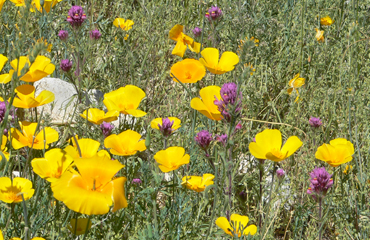…and right next to you, in the North American Sonoran Desert–quite a variety of flowers along the side of the Phoenix-Las Vegas highway, south of Wickenburg, on March 12: globe mallow, desert lupine, creosote bush, brittle bush, and many others. Amazing that there are so many natives right along the verge.
Again, lower elevations, farther south, means earlier flowering time.
Interesting to watch the populations change even with slight elevation changes, going up and down hills.
Look for places that have not been bulldozed or grazed, so there are fewer weeds and more natives.
Wetlands, swales, ditches, creeks, or washes may have unusual species.
This is prime time for flowers. They change so quickly, it’s worth looking as often as you can.





You must be logged in to post a comment.